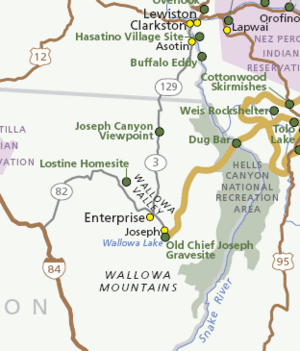Joseph Canyon facts for kids
Joseph Canyon is a very deep canyon, about 2,000 feet (610 meters) deep. It's located in northern Wallowa County, Oregon, and southern Asotin County, Washington. The Nez Perce people call it an-an-a-soc-um, which means "long, rough canyon."
Contents
Canyon Geography
Inside Joseph Canyon, you'll find Joseph Creek. This creek flows into the Grande Ronde River, which then joins the Snake River. The Snake River eventually flows into the mighty Columbia.
The canyon's rocks show how the land was formed. It's part of the Columbia Plateau, which was created by huge ancient lava flows. These flows are called the Columbia River Basalt Group. You can see layers of these lava flows and even some dikes (cracks filled with hardened lava) in the canyon walls. The bottom of the canyon also has sediments left behind by the massive Missoula Floods that happened long ago.
Canyon History
Joseph Canyon was named after Chief Joseph of the Nez Perce tribe. Many believe he was born in a cave on the east side of Joseph Creek.
Before European settlers arrived, the Nez Perce used the canyon's flat areas as a travel path. They moved between their summer camps in the Wallowa valley and their winter camps along the Grande Ronde and Snake rivers. The canyon was full of wildlife like elk, bighorn sheep, and mule deer. There were also many native plants that grew in the bunchgrass areas. Later, the Nez Perce grazed their horses on the canyon's grasslands.
In the late 1800s, pioneer settlers started to make their homes here. They raised sheep and cattle and tried to grow fruit in orchards. However, the land was very rocky, so it was hard to farm much.
Protecting Joseph Canyon
In the late 1990s, the Nez Perce tribe bought about 15,000 acres (61 square kilometers) of land in the Joseph Creek area. They did this to help protect the environment and wildlife.
These lands are now a safe home for many animals. Two threatened species that live here are the bald eagle and the Snake River steelhead fish. The canyon might also be home to other threatened animals like the lynx, Townsend's big-eared bat, and mountain quail. Some rare plant species, like Macfarlane's four-o’clock and Spalding's catchfly, also grow here.
Other animals that live in the canyon include bighorn sheep, elk, mule deer, blue grouse, golden eagles, and red-tailed hawks.
How to Visit Joseph Canyon
You can see a great view of the canyon from the Joseph Canyon Viewpoint. This viewpoint is a pullout along Oregon Route 3. It's one of 38 places that make up the Nez Perce National Historical Park.
The viewpoint is about 30 miles (48 km) north of Enterprise, Oregon. It's also about 11 miles (18 km) south of the Washington border. The viewpoint is located within the Wallowa–Whitman National Forest.
The canyon itself is private land owned by the Nez Perce Tribe. The tribe uses the land for ranching, hunting, and growing some grain crops. Another place to see views of the canyon is Fields Spring State Park.
Images for kids
-
The canyon as seen from Fields Spring State Park
-
Grande Ronde River in Joseph Canyon





